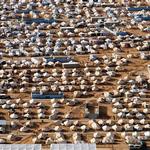Supercamp: The Middle East as Regional Refugee Camp
Paper presented at REFUGOV conference (online): Camps across the world: global and local perspectives
This paper takes a regional approach to encampment, thus expanding the spatial confines of refugee containment. In historical perspective the Middle East has been a refugee producing- and hosting region since the mid-18th century with forced displacement and deportation regimes as empires and states clashed and broke up leading to the first humanitarian relief, food aid, and tented camps from the early 19th century. The interwar and post-WWII period’s massive displacement led to formalizing the legal and institutional framework for the international protection to refugees and (1951 Refugee Convention) as well as established camps for refugees in Europe and the Middle East. In the latter, this began an era of encampment and that instituted camp-based responses to refugee crises as the default emergency measure to forced displacement both in ME-region and beyond. In the 1990s, inter-state and interventionist wars led to new regional displacement that was mostly contained within the Middle East region. Finally, the Syrian civil war (2012–present) and subsequent migration crisis lead to new border controls, containment, and return of refugees and migrants. Efforts to resolve the “European migration crises” implicated the Middle East in the EU’s migration management, thus becoming a refugee region that bridges the North-South divide through a system of detention and return. To this end, the paper hence argues for extending the camp-analogy to include a geographical region where refugees and migrants are interned and humanitarian aid and economic subsidies to the host country to delimit their mobility. A Supercamp hence can be defined as a bio-political region of forced immobility under humanitarian governance that is subsidized by an economic aid regime. In a wider sense, the creation a Middle East Supercamp can be seen as an extension of Orientalism’s imaginative geography of the Middle East.







